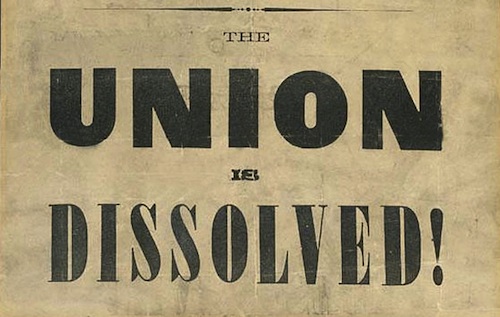The above embed is from CBS Sunday Morning yesterday, and last week NPR tackled the topic as well. It’s predominantly an issue in Colorado and California at present, and the central reasoning is rural citizens believing that state governments are primarily beholden to urban dwellers. Rural population is currently in decline to the point that secession ideas have popped up in Arizona, Florida and Michigan as well (although to much less effect). Rural areas are also losing legislative power.
A lot of the secession talk is ultimately a Catch-22: people want to break away from their main state because they lack voice, authority and power — but in order to break away, they’d need voice, authority and power. First the amendment would have to pass, then the original state would need to give blessing, and then U.S. Congress would need to give blessing. Overall, there’s about a snowball’s chance in hell of most of this happening anytime soon. Papers have been written about the topic. The idea of secession talk is more about drawing attention to a problem then it’s actually about breaking away from the state.
Rick Perry brought up secession in 2009, but had backtracked by 2011. Despite the impracticality of the idea, it keeps rearing its head. Pima County tried it, and some guy named Scott Strzelczyk is leading the charge in Maryland. (The idea there is for five conservative counties in western Maryland to break away and form their own state; Maryland, as a whole, is fairly liberal.) Secessionists tend to be more of the “crackpot” variety — in the video at the top here, the professor from Rice notes that often they’re simply people who don’t like the idea of “other,” i.e. others with different sexual orientations, skin color, etc. That said, some people the idea of secession is, in fact, inevitable:
Kentucky, Tennessee, Maine and West Virginia — among other areas, which is to say, Vermont — came to be because of secession, and proposals have been rampant for years in the so-called ’51st State Movement.’ South Carolina threw a ‘Secession Ball’ in 2010.
There was an article in The Daily Beast this past April arguing that red states and blue states should essentially form two Americas within America; this idea was mostly debunked by economists, citing even the notion that while the Czech Republic and Slovakia had a relatively solid split in terms of currency, those were two developing countries. A U.S. split would be much trickier.
In what might be the height of tech world / big money arrogance, Silicon Valley has also talked about secession. Bill Moyers has tied the whole secession piece in with the broader idea of ‘the sabotage of democracy.’ For a solid deep dive on secession and its parallels to 1861, read this piece.
Is it an American principle? It may well be in some respects — the arc of history has no doubt changed, but still — but to my mind, the bigger issue is that it’s predominantly bluster. In the modern climate, I can’t see (a) the original state and (b) U.S. Congress approve a change. If you did approve a 51st state from an existing state, say in northern California or Colorado, the floodgates would open and those issues would consume government and state-side politics. That can’t happen. We legitimately have bigger things to worry about. If you’re feeling disconnected from the seat of power in your state, use some good ol’ fashioned Yankee ingenuity and elbow grease to find a way to get closer to the gears that drive everything. The gap between haves and have-nots is insanely wide in the U.S. right now, yes, but groups can still change policies and ideas, even smaller groups. That’s the good part about a (mostly) free democracy. Focus on doing it through traditional means, not long-shot ones.

One Comment
Comments are closed.